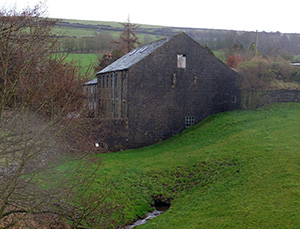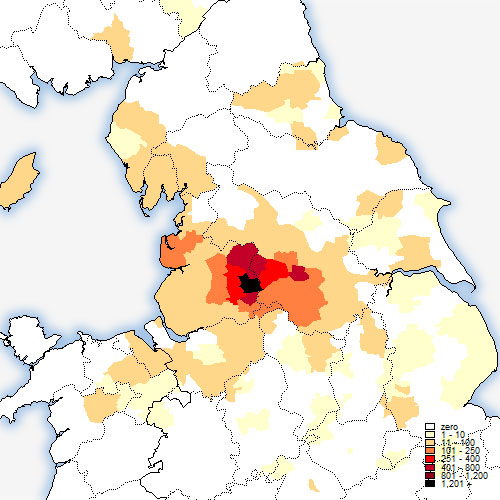Kerfies, Cleggies and all that.
 Clegg - From delver to delver.
Clegg - From delver to delver.
The area between Littleborough and Rochdale called Clegg is where Clegg Hall stands and it seems like a possible origin for the family name. Our branch of Cleggs certainly seem to have come from that direction. They were present in numbers in Sowerby in the 18th century and probably well before that. Many of the farms on the uplands between Sowerby, Crag Vale and Mytholmroyd were occupied by families bearing the Clegg name. In due course we may be able to show links to some of them.
The map below show the distribution of the family name, Clegg, in 1880. It is clearly centred around the Rochdale district.

From Farmer to Delver?
Whilst farming is the occupation that most folk would follow before the industrial revolution, stone delving is a natural diversification when the demand for building materials increases.
James Clegg was, or certainly became, a stone delver and moved to Mount Tabor across the valley from Sowerby where he was born. His father came from Sowerby and his mother was from Triangle in the valley below. Why he moved is uncertain. It could have been for work or for marriage. There are quarries and delphs in Sowerby as well but maybe they were better on the north side of the valley?.
James married Sarah Rothera whose father I think, owned or had the lease on a quarry...although he seemed to be a weaver by trade. Family tradition has it that Sarah was left a sizable amount of money which helped establish the future direction of her family.
James and Sarah Clegg had just one son, George, who must have been a bright lad and took a job as an accounts clerk at John Murgatroyd's woolen mill nearby, eventually becoming the bookkeeper. By borrowing money from Murgatroyd and others, he and his future father-in-law and fellow employee, Abraham Hollingrake, left to set up their own business, Hollingrake and Clegg. They leased mills, first in Wainstalls, then in Lower Wade Street in Halifax, before building their own mill complex on Pellon Lane in Halifax.
The business thrived for three or four generations until the latter half of the 20th century. It was then that my father-in-law had the unenviable task of managing the company through the decline of the woolen industry. He once reflected on the fact that after the mill closed he needed work and got a job with the water board at a newly built reservior building walls and working with stone: From delver to delver!
Back to George Clegg though. Allthough George, for whatever reason, was an only child, he had a reasonable sized family himself. Three girls, a son who died young, and another son, Arthur who is our families ancestor.
Both George and his father James were very religious men, being Wesleyans. They were involved in the Wesleyan Chapel in Mount Tabor and later Rhodes Street Chapel in Halifax. George was also a councillor, a magistrate and member of the Halifax Chamber of Commerce.
Arthur and Annie were the only two of George's children to marry. Annie married a methodist minister, Rev Albert Henry Walker, Ba. We used to see some of their subsequent family in Knaresbourough from time to time, particularly Charles Roger Walker.
Arthur married Phoebe Sarah Helen Beal, the daughter of a very entreprenurial victorian, William Henry Beal who came from Northamptonshire. Arthur and Phoebe had five children George, Roy, Len, Henry, and Mollie.
- Thomas Wentsilver Clegg
- Nancy Sutcliffe (m. 12 Nov 1809)
- James Clegg (b. 2 May 1810, d. 17 Mar 1878)
- Sarah Rothera (b. 1797, m. 28 Dec 1834, d. 4 Jan 1862)
- George Clegg, J. P. (b. 23 Apr 1839, d. 23 Dec 1895)
- Sarah Hollingrake (b. 31 Jan 1839, m. 28 Oct 1861, d. 3 Dec 1925)
- Sarah Ellen ("Nellie") Clegg (b. 4 Dec 1867, d. 31 Mar 1963)
- Annie Clegg (b. 26 Oct 1869, d. 26 Oct 1958)
- Rev Albert Henry Walker, Ba (b. 12 Jul 1862, m. 1891, d. 24 Nov 1945)
- Albert Norman Walker (b. 1893)
- Annie Margaret Walker (b. 29 May 1895, d. 9 Jul 1952)
- Harold Clegg Walker (b. 1901, d. 1964)
- Helen Mary Swinton Smith (b. 21 Dec 1901, d. 3 Jul 1963)
- Charles Roger Walker (b. 26 Mar 1932, d. 1999)
- Pauline Mary Warrilow (m. DEC Q 1965)
- Living (b. 1934)
- Charles Roger Walker (b. 26 Mar 1932, d. 1999)
- Helen Mary Swinton Smith (b. 21 Dec 1901, d. 3 Jul 1963)
- Rev Albert Henry Walker, Ba (b. 12 Jul 1862, m. 1891, d. 24 Nov 1945)
- George Henry Clegg (b. 21 Jul 1871, d. 21 Jun 1882)
- Mary Grace ("Polly") Clegg (b. 13 Sep 1873, d. 21 Mar 1927)
- Arthur Clegg (b. 19 Dec 1875, d. 4 Jan 1965)
- Phoebe Sarah Helen Beal (b. 30 Nov 1878, m. 13 Sep 1904, d. 10 Oct 1958)
- George Clegg (b. 30 Oct 1906, d. 17 Mar 1992)
- Florence ("Jill") Robinson (m. JUN Q 1952)
- Barbara Millicent Large (b. 17 Nov 1910, m. 2 Sep 1932, d. 5 May 1987)
- Judith Ann ("Judy") Clegg (b. 22 Jul 1933, d. 2019)
- Maxwell ("Bill") Boulton (b. 1930, d. 9 Mar 2012)
- Sarah Elizabeth Clegg (b. 1 Oct 1936, d. 14 Mar 1937)
- John George Everley Clegg (b. 7 Jun 1939, d. 14 Jul 1981)
- Living (b. 1943, m. 1964)
- Dominic Clegg (b. 15 Dec 1966, d. 27 Oct 2017)
- Living (m. 1995)
- Living (b. 1970)
- Dominic Clegg (b. 15 Dec 1966, d. 27 Oct 2017)
- Living (b. 1943, m. 1964)
- Judith Ann ("Judy") Clegg (b. 22 Jul 1933, d. 2019)
- Roy Beeson Clegg (b. 23 Jun 1908, d. 9 Jul 1994)
- Bettie Barbara Conibear (b. 9 Oct 1913, m. abt Feb 1936, d. 12 Jul 1996)
- Richard Conybeare Clegg (b. 7 Nov 1936, d. 18 Dec 2012)
- Living (b. 1941, m. 1961)
- Living (b. 1962)
- Belinda Clegg (b. 1964)
- Living (b. 1967)
- Living (b. 1944, m. 1998)
- Living (b. 1941, m. 1961)
- Penelope Clegg (b. 23 Jul 1939, d. Feb 2018)
- Richard Conybeare Clegg (b. 7 Nov 1936, d. 18 Dec 2012)
- Bettie Barbara Conibear (b. 9 Oct 1913, m. abt Feb 1936, d. 12 Jul 1996)
- Helen Marion ("Len") Clegg (b. 25 Jun 1911, d. 24 Apr 2005)
- Arthur Henry Clegg (b. 18 Jan 1916, d. 27 Oct 1980)
- Phoebe Mary ("Mollie") Clegg (b. 12 Aug 1919, d. 11 Jun 2005)
- George Clegg (b. 30 Oct 1906, d. 17 Mar 1992)
- Phoebe Sarah Helen Beal (b. 30 Nov 1878, m. 13 Sep 1904, d. 10 Oct 1958)
- Sarah Hollingrake (b. 31 Jan 1839, m. 28 Oct 1861, d. 3 Dec 1925)
- George Clegg, J. P. (b. 23 Apr 1839, d. 23 Dec 1895)
- Elizabeth Spencer (b. 7 Nov 1817, m. abt Jul 1862, d. 3 Apr 1889)
- Sarah Rothera (b. 1797, m. 28 Dec 1834, d. 4 Jan 1862)
- James Clegg (b. 2 May 1810, d. 17 Mar 1878)
- Nancy Sutcliffe (m. 12 Nov 1809)